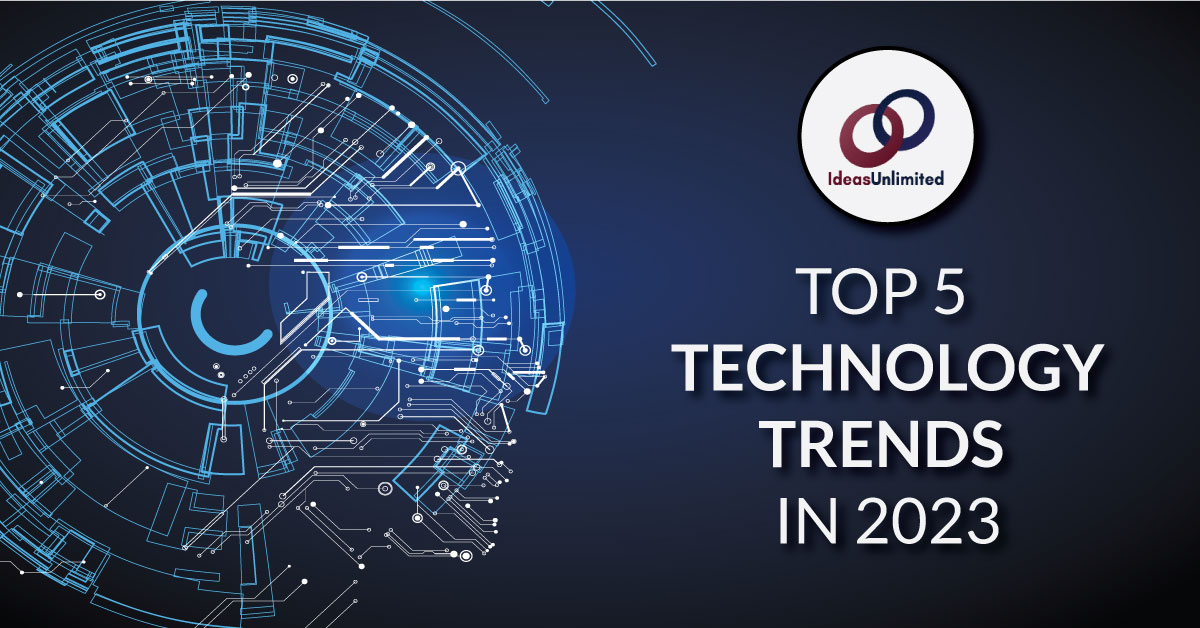In the last ten years, technology has been steadily developing with the promise of transforming our world. For most of the last decade, these technological developments have remained in the realm of R&D with little to show in terms of an actual product. But as time went on and larger companies, such as Google and OpenAI, accelerated their development, we began to see how many of these bleeding edge technologies could in fact offer real-world applications. In fact, 2023 might just be the year for several technology trends to become more than just a fad.
In this blog, we will highlight five breakthrough technologies, some that are now beginning to offer compelling products, and others that are extremely close to becoming a reality. While new advancements and innovations are taking place every day, we can expect these five to make the biggest impact this year.
1. Artificial Intelligence
In the last two years, no breakthrough has made a bigger splash than artificial intelligence.
It all began with machine learning. In short, machine learning allows software to self-learn rather than have programmers teach them. You may have seen glimpses of this in your everyday life. Smartphones that can perform predictive typing based on what you have written previously. Emails that can autocomplete by learning from your writing history.
The idea of using big data to program software is not new. IBM first demonstrated machine learning’s potential in 1996 by teaching thousands of chess games to a computer named Deep Blue that went on to defeat Garry Kasparov, possibly the greatest chess player of all time. While this was an entertaining spectacle, computer scientists were just getting started.
Over the following two decades, machine learning capabilities improved rapidly and new specializations emerged. Two that made the biggest impact were NLP (natural language processing) and neural networks. Combined, these two branches allowed software to generate text and audio that resembled human speech. You may be familiar with some of them. Cortana, Siri and Google Assistant have become a daily part of our routine. Research shows that almost 97% of mobile users are using these voice-based personal assistants that are based on AI.
On the eve of 2023 however, the biggest disruption occurred when OpenAI released ChatGPT; a natural language text generator. Its results were so convincing, many saw it as the arrival of true artificial intelligence.
Even though we are only half way into this year, 2023 has been the year of AI, with every single tech giant rushing to put out their own version of a natural language model product. The projects are simply off the charts. Statista currently values the AI industry at $100 billion and expects it to grow twenty times to nearly $2 trillion by 2030.
Only time will tell if these predictions are true. But the buzz surrounding AI has reached a fever-pitch and shows no sign of slowing down.
2. Automation
Automation and task scheduling is already creeping into many applications that we use everyday. From autocompleting email to social media post queueing, automation in software is essentially accomplishing the same thing that machines in factories did almost a century ago; reducing monotonous busy-work and replacing it with efficient workflows.
Many workers resonate with automated applications. In one survey, 94% of office workers reported not having enough time to complete their tasks within the deadline. Digitization of knowledge-based work has opened the door for automation in many sectors such as finance, education, information technology and media. For 2023, automation is expected to grow at an astonishing rate of 200%. One space in which we are already seeing automation take effect is in web development. With sites like WordPress and Wix, company organizations can now create their very own websites with little to no coding.
One misconception about automation is that it is exclusive for corporations. That could not be further from the truth. In a survey conducted among SMBs, 88% of small company owners agreed that automation helped them compete with larger enterprises. Automation offers efficiency; doing more with less. This gives startups the opportunity to match their service quality with more established brands that have a resource advantage.
3. Internet of Things (IoT)
For the uninitiated, the internet of things (or IoT for short) refers to devices that can be operated via the internet. Home appliances that can be controlled by a smartphone, smartwatches that track your daily activity, and self-driving cars are all examples of IoT.
While the term IoT was first coined as early as 1999, it has taken almost two decades of development for it to become a real trend. The first breakthrough came when Tesla announced that their electric cars will be operated with an app launched in 2012. After five more years of update, the adoption rate skyrocketed and more car manufacturers offered their buyers the ability to control vehicles with their smartphone.
Factories are using ‘smart-manufacturing’ so they can control their assembly lines from an office hundreds of miles away. Doctors are using wearable health-tracking devices to study their patient’s vitals such as blood pressure, heart rate and sleep patterns. IoT adoption is progressing exponentially with nearly 15 billion active devices & machinery. According to Gartner, this number is expected to double by as early as 2030.
4. Web 3.0
Web 3.0, or simply web3, is essentially the same internet we use everyday, only with its data maintained over a blockchain. The internet, at its most basic, is a network of devices connected with each other.
Web3 is a decentralized network of devices where data is stored autonomously that is not controlled by any person or company. This completely changes the way we think about e-commerce, data security and privacy. Without large corporations acting as a middleman, web3 allows users to carry out online activities without the need to go through other services. With built-in support for crypto-wallets, goods and services can be exchanged without having to go through banks. Information on web3 will not be stored on a single database, but on a ledger that is maintained by devices around the world.
Understanding web3 more deeply can be complex. Its critics are pointing out that it is essentially a new term for the already existing cryptocurrency. But in essence, web3 is simply a digital ecosystem where all blockchain solutions can coexist without the need of tech giants that currently dominate the internet. It might be the key to restoring a sense of trust in an age where privacy is a big concern. In fact, a recent survey by Gartner found out that 20% of major organizations are projected to move to digital currency and web3 by the end of 2023.
5. Quantum Computing
Transistors are the building blocks of computers. By making transistors smaller, more can be fitted on a single chip which allows us to build faster computers. However, engineers have run into a problem.
The smallest transistor ever built is 0.3 nanometers. For comparison, the diameter of a hydrogen atom is 0.1 nanometers. We cannot make transistors any smaller because the laws of physics simply won’t allow us. Conventional computers are reaching their absolute limit. Therefore, we have to start exploring other possibilities. As of right now, there seems to be only one way forward; quantum computers.
The computers we use everyday perform calculations using ‘bits’ (1’s and 0’s). Quantum computers are different. Instead, they use something called ‘qubits’. Information carriers that can represent 1, 0 or simultaneously 1 AND 0. This might sound strange but in the world of quantum mechanics, this makes perfect sense. Quantum computers use advanced quantum physics principles, such as superposition and entanglement, to perform certain tasks at nearly 160 million times the speed of a modern-day supercomputer.
It’s important to note that quantum computers will not replace current hardware entirely. In fact, a simple laptop is a much more feasible option for everyday use such as email, browsing, games and videos. Quantum computers are, however, much better at sifting through big data or charting simulations. When the first quantum computer products begin to arrive, they will most likely stay in the back-end helping engineers and scientists. Mass consumer hardware might not materialize for many years that follow.
So why did quantum computers make the list? Because on the eve of 2023, Precedence Research valued the quantum computing sector at $10 billion and projected it to reach $125 billion by 2050. Tech conglomerates, such as IBM, have also significantly increased investment in quantum computing and have made it their primary R&D focus for the coming years.
There is still a long road ahead for quantum computers. But with transistor-based machines reaching their pinnacle, the world now looks forward to a quantum leap in technology.
Keeping up with the latest updates in tech can be challenging. Everyday, we see new bold innovations dominate the news cycle, promising disruption in the way we live. In this blog, our goal was to condense all the latest in technology into the five most important things our readers should be paying attention towards in 2023. However, we’d love to know what you think will be the next technology to spark a revolution. Comment below and let us know!
And for more from IdeasUnlimited, be sure to visit our blog page.









